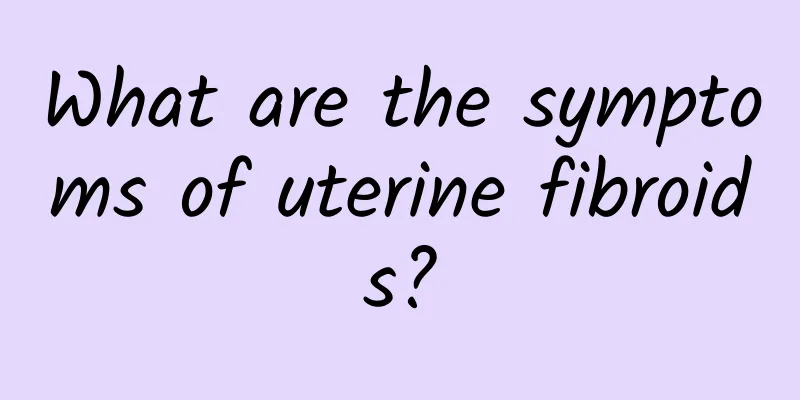How do I know if I have chronic pelvic inflammatory disease?

|
How do you know if you have chronic pelvic inflammatory disease? Pelvic inflammatory disease, especially chronic pelvic inflammatory disease, has many symptoms. It can recur due to fatigue or emotional changes. It becomes a stubborn gynecological disease and seriously affects women's life, work and physical and mental health. In addition, acute pelvic inflammatory disease can also cause chronic pelvic inflammatory disease if it is not properly and thoroughly treated or the patient's physical condition is poor and the course of the disease is prolonged. Adult women should pay attention if they have the following symptoms of chronic pelvic inflammatory disease: Symptoms of chronic pelvic inflammatory disease include increased menstrual flow - due to pelvic congestion, patients may have increased menstruation; when ovarian function is impaired, there may be menstrual disorders. Symptoms of chronic pelvic inflammatory disease include lower abdominal pain - it can manifest as lower abdominal pain of varying degrees. Mild cases include lower abdominal discomfort. Severe cases include pain and a feeling of heaviness in the lumbar region. It is often aggravated after fatigue, sexual intercourse, before and during menstruation. Dysmenorrhea, a symptom of chronic pelvic inflammatory disease, often occurs 2-3 days before menstruation and worsens during menstruation. Infertility is a symptom of chronic pelvic inflammatory disease - often secondary to fallopian tube obstruction caused by chronic salpingitis. The systemic symptoms of chronic pelvic inflammatory disease are not obvious - the systemic symptoms of patients with chronic pelvic inflammatory disease are mostly not obvious, sometimes they may have low fever, fatigue, increased vaginal discharge, etc. At the same time, some patients may experience symptoms of neurasthenia, such as lack of energy, general discomfort, insomnia, etc. When the patient's resistance is poor, acute attacks are prone to occur. The hospital uses advanced pelvic inflammatory interventional therapy to effectively treat pelvic inflammatory disease. Pelvic interventional therapy is to directly introduce high-concentration, high-efficiency drugs into the lesion site through puncture technology under the guidance of the B-ultrasound visual system, repair damaged tissues, accelerate the regeneration of new cells, and change some of the shortcomings of traditional therapies. It is especially effective for patients with fertility requirements and patients with recurrent pelvic inflammatory disease who have not been cured for a long time. If you have other questions about the symptoms of chronic pelvic inflammatory disease, please consult our online experts for more information. Pelvic inflammatory disease http://www..com.cn/fuke/pqy/ |
<<: Does pelvic inflammatory disease cause dysmenorrhea symptoms in women?
>>: How to prevent acute adnexitis?
Recommend
Nutritional diet for Bartholinitis
Bartholin's gland cyst can eat some foods tha...
What are the main causes of dysmenorrhea?
Dysmenorrhea may be caused by diet, cold, cervici...
What is the nature of ovarian chocolate cyst?
What is the nature of ovarian chocolate cyst? It ...
What are the specific symptoms of vulvar leukoplakia?
The symptoms of vulvar leukoplakia are not obviou...
Eat less to lose weight? How to calculate daily calories for weight loss
Everyone knows that to lose weight you need to &q...
Celebrity primitive diet loses 10 kg after giving birth
The "Paleo" diet, also known as the cav...
How long does it take for bleeding to occur after menstruation stops in an ectopic pregnancy?
Ectopic pregnancy usually causes bleeding after 6...
Two dangers of ovarian cysts that need to be watched out for
It is well known that ovarian cysts are very harm...
Does pelvic inflammatory disease cause a low-grade fever? No obvious high fever
If the infection is not particularly severe, pelv...
Do uterine fibroids require surgery?
Uterine fibroids are benign tumors formed by the ...
The causes of pelvic effusion are as follows:
In life, pelvic inflammatory disease has affected...
These are all manifestations of the dangers of uterine fibroids.
Uterine fibroids are very common in life, and man...
Can Bulletproof Coffee for Breakfast Control Blood Sugar and Help Lose Weight? Doctor: Be careful, these situations may ruin your health
You don’t have to drink only milk or soy milk for...
What to do if pelvic effusion is found in early pregnancy
"What should I do if I find pelvic effusion ...
Postpartum starch bomb potato white toast eat less
The purpose of postpartum confinement for women i...









